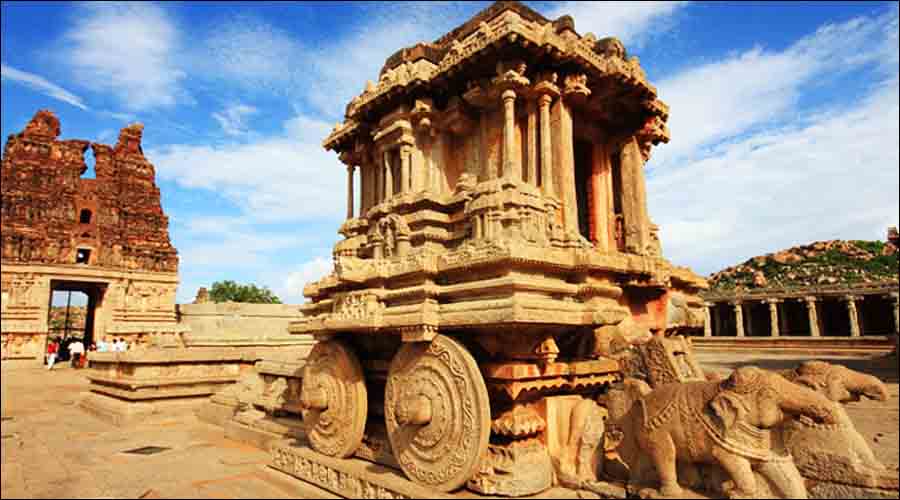Hampi is nothing short of cultural poetry. Home to evocative medieval ruins of the Vijaynagar Empire and the capital of three generations of Hindu rulers, Hampi reached the height of its glory under the rule of Krishnadevaraya in the 16th century.
Hampi in Karnataka

It is a place that the discerning traveller lingers over. Not least because this UNESCO-accredited World Heritage Site, on the banks of the river Tungabhadra, is ruggedly spectacular. If the granite boulders that dot the landscape could speak, they’d tell of a time when precious stones embellished the stone structures, of a time when kings were weighed on a balance against gold for distribution among the poor.
Writes Dhanwanti Nayak in her article, “Hampi, the lost Empire” – “it is a place that was reputedly even larger than the Rome of its time….an Empire that covered most of peninsular India at its peak. The kingdom took root in the environs of Hampi when Harihara and Bukka, two brothers from the Sangama family, established an empire around 1336. In all, 23 kings from four dynasties ruled the land over a period of 300 years. Krishnadevaraya and his half-brother Achyuta Raya were its most legendary monarchs. They were finally defeated in the battle of Talikota in 1564 which resulted in the mass pillaging of Hampi. Such were its riches, it was said, that it took hundreds of elephants more than six months to carry the loot out of Hampi.”
It is often a challenge to linger for a few days. For there’s never respite from the visual stimulation of offer: For example, as you send your way to and through the royal centres of the ancient empire, you encounter everything from Sugriva’s cave, consisting of a natural cleft between granite boulders, an awe-inspiring Hazara Rama Temple, an aqueduct that was used to transport water from the river Tungabhadra through to the royal centers. An archaeological museum along the way adds to the experience. As does the guide you hire, for not only does he regal you with stories as you go along, but he also furnishes explanations on details you might otherwise overlook. For instance, it is he who informs you that it was the rocky terrain and surrounding hillocks that made Hampi an ideal defensive location for kings who at the time depended on the conquest to amass more wealth.
Although you can hire a rickshaw as many tourists do to rush you through all the major sites in a day, exploration is best done over a week and as much as possible, on foot. If you choose to walk around slowly, you will have time to do more than just exclaim in rapture over the temples. Instead, you can meditate over the exquisite details like the panel of celestial nymphs riding on parrots or mythical leonine beasts that adorn the outer piers of the temple.
Situated on the banks of the river, a wander through the Sacred Centre puts all senses to work. One look at the Vitthala Temple, the grandest of all monuments here, is clear evidence of this fact. Your eyes drink in the elaborate columned halls. Your ears tune in to the musical columns that emit different tones when lightly tapped. Your nose tells you to keep moving as there are lots to sniff out and see: from the impressive Virupaksha Temple dedicated to the goddess Pampa, to the Hemakuta Hill scattered with numerous pre and early Vijayanagar shrines.
The Royal Centre nearby reminds one of a lost Eden. You’ll pass the Queen’s bath, an open-air structure designed for royal recreation and the Lotus Mahal, which was once a speculation chamber for the king. But the bliss that comes from wandering through poetry in stone is most felt at sunrise and sunset — when you’re looking at an elephant wandering towards the river for this bath or the priests trooping towards the temple for prayer. You reflect on your day’s adventures as you scour the flea market for souvenirs made from banana fibers and river grass.
Like Hampi, Pattadakal is picturesquely situated on the banks of a river and is also a UNESCO accredited World Heritage Site. It is situated on the Malaprabha River and was the coronation town of the early Chalukyas and mainly used for royal festivities. This ancient settlement boats artistic achievements that revolve around 8th-century temple styles that combine North and South Indian architecture. While admiring the Galaganatha Temple with its tower or the unusual Kashi Vishwanath Temple, pay attention to the minute details. For instance, Shiva appearing out of the fiery linga at the Virupaksha Temple or Nataraja dancing on a ceiling panel of the Papanatha Temple or the battle between Arjuna and Shiva depicted on the Virupaksha temple.
It is with a desire to return to and revisit Hampi and Pattadakal that you leave. What else can be expected as you leave spaces that look like they were created by a poet, only one whose words were uttered in stone?
A Window to the Past
In addition to time spent exploring Hampi and Pattadakal, stop at the historic hamlet of Anegundi that lies on the opposite banks of the river Tungabhadra. What adds to the charm of the visit is that Anegundi may be reached by circular-shaped boats called coracles which look like one half of a hollow coconut.
When you arrive at Anegundi, dilapidated temples, palaces and bathing Ghats provide an insight into the former glory of a place that was a significant settlement before the establishment of Vijayanagar. The mud-clad houses and picturesque views of the river add to the charm.

 Call
Call